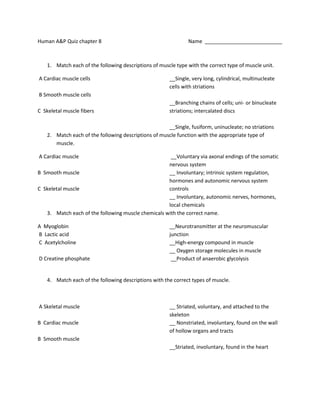Signaler
Partager

Recommandé
Recommandé
Contenu connexe
Similaire à Human a&p quiz
Similaire à Human a&p quiz (20)
science grade 6-explain how the organs and organs system work

science grade 6-explain how the organs and organs system work
Human anatomy EXAM 1 Cells Tissues Planes Techniques in radiology 

Human anatomy EXAM 1 Cells Tissues Planes Techniques in radiology
Creation of a synthetic organ - the skeletal striated muscle

Creation of a synthetic organ - the skeletal striated muscle
1. Describe in your own words the anatomy of a muscle. This sho.docx

1. Describe in your own words the anatomy of a muscle. This sho.docx
Chapter 4 A Tour of the CellChapter 4 A Tour of the CellName.docx

Chapter 4 A Tour of the CellChapter 4 A Tour of the CellName.docx
NCERT Solutions | Class IX | Science (Biology) | Chapter 6 | Tissues

NCERT Solutions | Class IX | Science (Biology) | Chapter 6 | Tissues
Dernier
Dernier (20)
Factors Affecting child behavior in Pediatric Dentistry

Factors Affecting child behavior in Pediatric Dentistry
CURRENT HEALTH PROBLEMS AND ITS SOLUTION BY AYURVEDA.pptx

CURRENT HEALTH PROBLEMS AND ITS SOLUTION BY AYURVEDA.pptx
Compare home pulse pressure components collected directly from home

Compare home pulse pressure components collected directly from home
Why invest into infodemic management in health emergencies

Why invest into infodemic management in health emergencies
Hemodialysis: Chapter 2, Extracorporeal Blood Circuit - Dr.Gawad

Hemodialysis: Chapter 2, Extracorporeal Blood Circuit - Dr.Gawad
Relationship between vascular system disfunction, neurofluid flow and Alzheim...

Relationship between vascular system disfunction, neurofluid flow and Alzheim...
Muscle Energy Technique (MET) with variant and techniques.

Muscle Energy Technique (MET) with variant and techniques.
Denture base resins materials and its mechanism of action

Denture base resins materials and its mechanism of action
Vaccines: A Powerful and Cost-Effective Tool Protecting Americans Against Dis...

Vaccines: A Powerful and Cost-Effective Tool Protecting Americans Against Dis...
Cervical screening – taking care of your health flipchart (Vietnamese)

Cervical screening – taking care of your health flipchart (Vietnamese)
Human a&p quiz
- 1. Human A&P Quiz chapter 8 Name ___________________________ 1. Match each of the following descriptions of muscle type with the correct type of muscle unit. A Cardiac muscle cells B Smooth muscle cells C Skeletal muscle fibers __Single, very long, cylindrical, multinucleate cells with striations __Branching chains of cells; uni- or binucleate striations; intercalated discs __Single, fusiform, uninucleate; no striations 2. Match each of the following descriptions of muscle function with the appropriate type of muscle. A Cardiac muscle B Smooth muscle C Skeletal muscle __Voluntary via axonal endings of the somatic nervous system __ Involuntary; intrinsic system regulation, hormones and autonomic nervous system controls __ Involuntary, autonomic nerves, hormones, local chemicals 3. Match each of the following muscle chemicals with the correct name. A Myoglobin B Lactic acid C Acetylcholine D Creatine phosphate __Neurotransmitter at the neuromuscular junction __High-energy compound in muscle __ Oxygen storage molecules in muscle __Product of anaerobic glycolysis 4. Match each of the following descriptions with the correct types of muscle. A Skeletal muscle B Cardiac muscle B Smooth muscle __ Striated, voluntary, and attached to the skeleton __ Nonstriated, involuntary, found on the wall of hollow organs and tracts __Striated, involuntary, found in the heart
- 2. 5. Which of the following muscles is voluntary? a) The muscle that extends the arm at the elbow b) The muscle in the wall of the heart. c) The muscle of the stomach d) The muscle in the wall of the urinary bladder 6. Which of the following is NOT a characteristic of skeletal muscle contraction? a) It is voluntary. b) It can exert tremendous power. c) It can contract for long periods of time without tiring. d) It contracts rapidly. 7. Which of the following characteristics is unique to smooth muscle? a) Hyperplasia b) The absence of striations c) Stress relaxation response d) The ability of ATP to energize the sliding process 8. State three examples of reverse peristalsis. a. b. c. 9. State three examples of adverse effects of anabolic steroid use to build muscular strength and endurance. a. b. c.
- 3. 10. Make a list of twenty-five muscles and determine by which criteria each muscle derived its name. Students should categorize the muscles they have chosen by size, location, number of origins, shape, direction of the muscle fibers, action, and origin/insertion points. Muscles Which criteria each muscle derived its name? 11. Give one example of the locations of multiunit and visceral smooth muscles. Multiunit Visceral Location